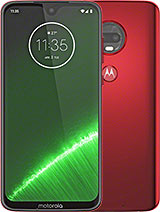- Home
- Mobile
- Samsung Galaxy Note 20 Ultra vs Motorola Moto G7 Plus
Samsung Galaxy Note 20 Ultra vs Motorola Moto G7 Plus
Rs. 219,999

|
| Network |
|---|
| Technology | GSM / CDMA / HSPA / EVDO / LTE |
| 2G bands | GSM 850 / 900 / 1800 / 1900 - SIM 1 & SIM 2 (dual-SIM model only) |
| CDMA 800 / 1900 |
| 3G bands | HSDPA 850 / 900 / 1700(AWS) / 1900 / 2100 |
| CDMA2000 1xEV-DO |
| 4G bands | LTE |
| Speed | HSPA 42.2/5.76 Mbps, LTE-A (7CA) Cat20 2000/200 Mbps |
|
| Launch |
|---|
| Announced | 2020, August 05 |
| Status | Release on, August 28 |
|
| Body |
|---|
| Dimensions | 164.8 x 77.2 x 8.1 mm (6.49 x 3.04 x 0.32 in) |
| Weight | 208 g (7.34 oz) |
| Build | Glass front (Gorilla Glass Victus), glass back (Gorilla Glass Victus), stainless steel frame |
| SIM | Single SIM (Nano-SIM and/or eSIM) or Hybrid Dual SIM (Nano-SIM, dual stand-by) |
| Samsung Pay (Visa, MasterCard certified)
IP68 dust/water resistant (up to 1.5m for 30 mins)
Stylus, 9ms latency (Bluetooth integration, accelerometer, gyro) |
|
| Display for Samsung Galaxy Note 20 Ultra |
|---|
| Type | Dynamic AMOLED 2X capacitive touchscreen, 16M colors |
| Size | 6.9 inches, 117.7 cm2 (~92.5% screen-to-body ratio) |
| Resolution | 1440 x 3088 pixels (~494 ppi density) |
| Protection | Corning Gorilla Glass Victus |
| HDR10+
Always-on display
120Hz@FHD/60Hz@QHD refresh rate |
|
| Platform |
|---|
| OS | Android 10, One UI 2.1 |
| Chipset | Exynos 990 (7 nm+) - Global
Qualcomm SM8250 Snapdragon 865+ (7 nm+) - USA |
| CPU | Octa-core (2x2.73 GHz Mongoose M5 & 2x2.50 GHz Cortex-A76 & 4x2.0 GHz Cortex-A55) - Global
Octa-core (1x3.00 GHz Kryo 585 & 3x2.42 GHz Kryo 585 & 4x1.8 GHz Kryo 585) - USA |
| GPU | Mali-G77 MP11 - Global
Adreno 650 - USA |
|
| Memory |
|---|
| Card slot | microSDXC (uses shared SIM slot) |
| Internal | 256GB 8GB RAM |
| UFS 3.1 |
|
| Main Camera |
|---|
| Triple | 108 MP, f/1.8, 26mm (wide), 1/1.33", 0.8µm, PDAF, Laser AF, OIS
12 MP, f/3.0, 103mm (periscope telephoto), 1.0µm, PDAF, OIS, 5x optical zoom, 50x hybrid zoom
12 MP, f/2.2, 13mm (ultrawide), 1/2.55", 1.4µm |
| Features | LED flash, auto-HDR, panorama |
| Video | 8K@24fps, 4K@30/60fps, 1080p@30/60/240fps, 720p@960fps, HDR10+, stereo sound rec., gyro-EIS & OIS |
|
| Selfie camera |
|---|
| Single | 10 MP, f/2.2, 26mm (wide), 1/3.2", 1.22µm, Dual Pixel PDAF |
| Features | Dual video call, Auto-HDR |
| Video | 4K@30/60fps, 1080p@30fps |
|
| Sound |
|---|
| Loudspeaker | Yes, with stereo speakers |
| 3.5mm jack | No |
| 32-bit/384kHz audio
Tuned by AKG |
|
| Comms |
|---|
| WLAN | Wi-Fi 802.11 a/b/g/n/ac/6, dual-band, Wi-Fi Direct, hotspot |
| Bluetooth | 5.0, A2DP, LE, aptX |
| GPS | Yes, with A-GPS, GLONASS, BDS, GALILEO |
| NFC | Yes |
| Radio | FM radio (Snapdragon model only; market/operator dependent) |
| USB | 3.2, Type-C 1.0 reversible connector, USB On-The-Go |
|
| Features |
|---|
| Sensors | Fingerprint (under display, ultrasonic), accelerometer, gyro, proximity, compass, barometer |
| Samsung Wireless DeX (desktop experience support)
ANT+
Bixby natural language commands and dictation |
|
| Battery |
|---|
| Non-removable Li-Ion 4500 mAh battery |
| Charging | Fast charging 25W
USB Power Delivery 3.0
Fast Qi/PMA wireless charging
Reverse wireless charging 9W |
Coming Soon

|
| Network |
|---|
| Technology | GSM / HSPA / LTE |
| 2G bands | GSM 850 / 900 / 1800 / 1900 - SIM 1 & SIM 2 (dual-SIM model only) |
| 3G bands | HSDPA 850 / 900 / 1700(AWS) / 1900 / 2100 |
| 4G bands | LTE band 1(2100), 2(1900), 3(1800), 4(1700/2100), 5(850), 7(2600), 8(900), 18(800), 19(800), 20(800), 26(850), 28(700), 38(2600), 40(2300), 41(2500) |
| Speed | HSPA 42.2/5.76 Mbps, LTE-A (2CA) Cat13 600/50 Mbps |
| GPRS | Yes |
| EDGE | Yes |
|
| Launch |
|---|
| Announced | 2019, February |
| Status | Available. Released 2019, March |
|
| Body |
|---|
| Dimensions | 157 x 75.3 x 8.3 mm (6.18 x 2.96 x 0.33 in) |
| Weight | 176 g (6.21 oz) |
| Build | Front/back glass (Gorilla Glass 3), aluminum frame |
| SIM | Single SIM (Nano-SIM) or Dual SIM (Nano-SIM, dual stand-by) |
| Splash resistant |
|
| Display for Motorola Moto G7 Plus |
|---|
| Type | LTPS IPS LCD capacitive touchscreen, 16M colors |
| Size | 6.2 inches, 96.2 cm2 (~81.4% screen-to-body ratio) |
| Resolution | 1080 x 2270 pixels, 19:9 ratio (~405 ppi density) |
| Protection | Corning Gorilla Glass 3 |
|
| Platform |
|---|
| OS | Android 9.0 (Pie) |
| Chipset | Qualcomm SDM636 Snapdragon 636 (14 nm) |
| CPU | Octa-core 1.8 GHz Kryo 260 |
| GPU | Adreno 509 |
|
| Memory |
|---|
| Card slot | microSD, up to 512 GB (dedicated slot) |
| Internal | 64 GB, 4 GB RAM |
|
| Main Camera |
|---|
| Dual | 16 MP, f/1.7, 1.22µm, PDAF, OIS
5 MP, f/2.2, depth sensor |
| Features | Dual-LED dual-tone flash, panorama, HDR |
| Video | 2160p@30fps, 1080p@30/60/120fps, gyro-EIS |
|
| Selfie camera |
|---|
| Single | 12 MP, 1.25µm |
| Features | HDR |
| Video | 2160p@30fps, 1080p@30fps |
|
| Sound |
|---|
| Loudspeaker | Yes, with stereo speakers |
| 3.5mm jack | Yes |
| Active noise cancellation with dedicated mic
Dolby Audio |
|
| Comms |
|---|
| WLAN | Wi-Fi 802.11 a/b/g/n/ac, dual-band, WiFi Direct, hotspot |
| Bluetooth | 5.0, A2DP, LE, EDR, aptX |
| GPS | Yes, with A-GPS, GLONASS, GALILEO |
| NFC | Yes (Europe model) |
| Radio | FM radio |
| USB | 2.0, Type-C 1.0 reversible connector |
|
| Features |
|---|
| Sensors | Fingerprint (rear-mounted), accelerometer, gyro, proximity |
|
| Battery |
|---|
| Non-removable Li-Ion 3000 mAh battery |
| Charging | Fast battery charging 27W
Quick Charge 4, USB Power Delivery 3.0 |
|
| Tests |
|---|
| Performance | Basemark OS II: 2422 / Basemark OS II 2.0: 1999
Basemark X: 15004 |
| Display | Contrast ratio: 1425 (nominal), 3.010 (sunlight) |
| Camera | Photo / Video |
| Loudspeaker | Voice 70dB / Noise 72dB / Ring 84dB |
| Audio quality | Noise -93.3dB / Crosstalk -93.8dB |
| Battery life | |
|
Popular Mobile Comparisons





